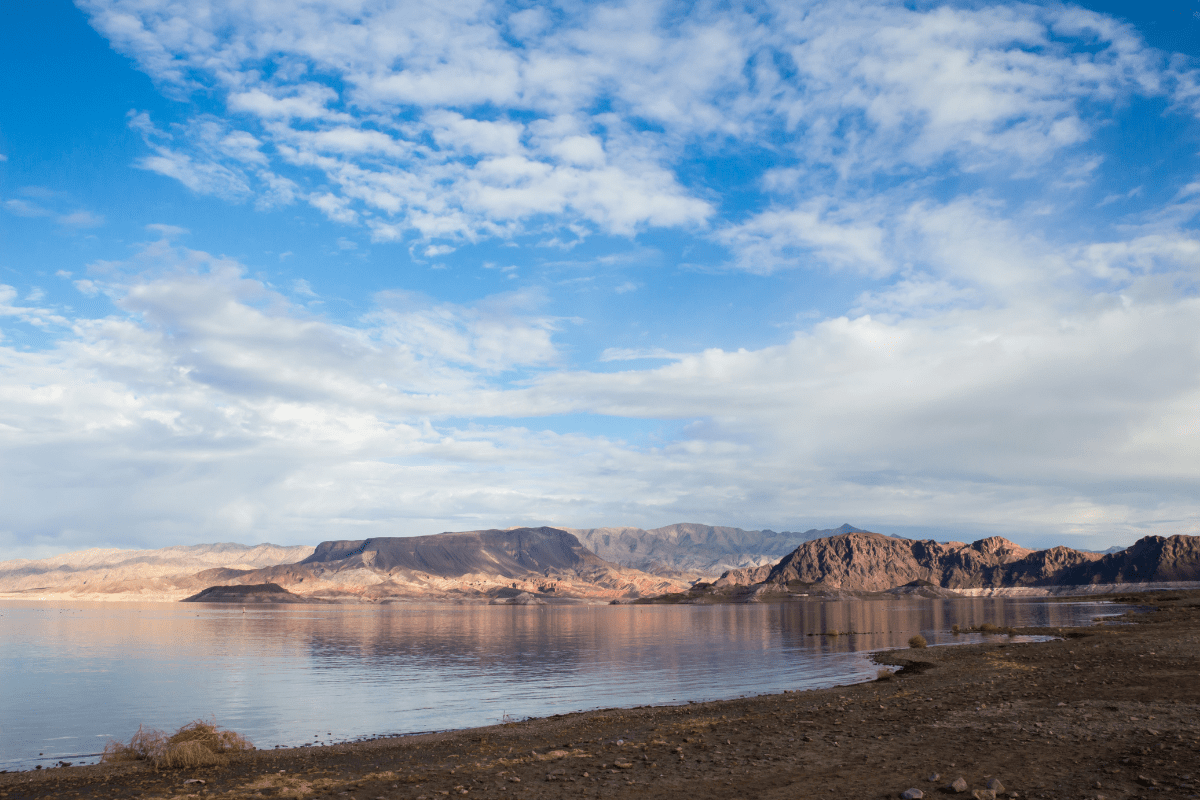Living in Henderson puts you in the sweet spot for Southwest adventures… close enough to Vegas for a decent airport and far enough out to hit genuine wilderness in under an hour. Within two hours of your front door, you can explore ancient petroglyphs, boat on massive lakes, or escape to mountains that actually have snow. Here's your guide to destinations that deliver maximum adventure with minimal planning hassles.
Close-to-home gems that pack a punch
The beauty of Henderson's location becomes obvious once you start exploring beyond the familiar casino glow. You're positioned perfectly between desert wonderlands, historic sites, and that rare Nevada commodity: actual water recreation.
Red Rock Canyon National Conservation Area
Red Rock Canyon sits just 46 minutes away via I-215 West and Charleston Boulevard, making it Henderson's most accessible natural escape. The $20 vehicle pass covers seven days, though here's the catch most people discover too late: you need timed entry reservations from October through May. The slots fill up fast, especially those coveted 8-10am windows when temperatures stay bearable and you can actually photograph the red cliffs without squinting.
The 13-mile scenic drive winds through geological formations where ancient sea beds transformed into towering red cliffs and cream-colored sandstone. Rangers consistently recommend starting any hiking before 8am in summer when temperatures routinely exceed 115°F by noon… this isn't tourist paranoia, it's legitimate desert survival advice.
Trail difficulty breakdown:
- Lost Creek Trail: 0.75 miles, petroglyphs
- Calico Tanks: moderate, natural pools
- Turtlehead Peak: 5 miles, serious elevation
- Water requirement: 1 gallon per person
The visitor center provides the only reliable water source, so don't gamble on finding natural springs. Book your timed entry slots well ahead, especially for weekend visits.
Lake Mead's surprising versatility
Boulder Beach offers the closest Lake Mead access at just 19 minutes via Lake Mead Parkway. The $25 vehicle pass provides seven days of access to America's largest reservoir, though drought has fundamentally changed the experience. Current water levels hover around 36% capacity, creating longer walks to reach the water and exposing previously submerged hazards that demand extra boating caution.
Don't let the low water levels discourage you. Las Vegas Boat Harbor at Hemenway Harbor operates as the lake's primary marina with over 1,500 slips, about 30-35 minutes from Henderson. Boat rentals range from $300-500 daily for pontoons to $100-200 hourly for jet skis, with mandatory safety courses regardless of your experience level.
Swimming remains popular at Boulder Beach where water temperatures reach 75-85°F in summer. Life jackets get strongly recommended—drowning leads the cause-of-death statistics in national parks, and Lake Mead's size creates deceptively challenging conditions even for strong swimmers.
Historic destinations with genuine character
Henderson's proximity to Depression-era construction projects and Old West mining towns creates opportunities for history buffs who want substance over theme park reconstructions.
Boulder City's authentic past
Boulder City preserves a unique slice of American history as the planned community built to house Hoover Dam workers, just 20 minutes from Henderson. The Historic District contains 408 buildings from 1931-1942, representing Nevada's largest concentration of National Register sites. These aren't replica buildings, but the actual structures where dam workers lived and worked during one of America's most ambitious infrastructure projects.
The Boulder City/Hoover Dam Museum operates daily from 7am-7pm with free admission, housed in the 1933 Boulder Dam Hotel that still accepts overnight guests. The museum focuses on the human story of dam construction rather than just engineering facts, including the company town's unusual prohibition of gambling and alcohol that persists today.
Hoover Dam engineering spectacle
The $15 self-guided visitor center tour provides context for this Depression-era achievement, while the $40 guided dam tour takes you into the structure's inner workings. Parking costs $10 in the Nevada-side garage, and all vehicles undergo security screening. Smart visitors arrive before 9am to avoid both crowds and afternoon sun that makes the observation deck genuinely uncomfortable.
The guided tours descend into the power plant and generator rooms where you can feel the massive turbines vibrating through the concrete. It's genuinely impressive engineering that becomes more remarkable when you consider it was completed in 1936 using 1930s technology and manual labor.
Nevada State Railroad Museum adventures
The Nevada State Railroad Museum offers weekend train rides on the historic Boulder Branch Line for just $10 per adult, with departures at 10am, noon, 2pm, and 4pm. The 40-minute journey follows the original route used to transport Hoover Dam construction materials, using vintage locomotives and restored passenger cars. Summer afternoon rides get suspended because even the railroad acknowledges that sitting in metal cars during peak heat crosses into masochism territory.
Special events like Halloween Express and Santa Train sell out quickly, so check the museum schedule if you're planning around holidays.
Hour-plus destinations worth the drive
Sometimes the best adventures require a bit more commitment, but these destinations deliver experiences you simply can't find closer to home.
Valley of Fire's otherworldly landscapes
Valley of Fire State Park requires a 1 hour 26-minute drive northeast via I-15, but rewards visitors with Nevada's oldest state park where iron oxide has painted sandstone in impossible shades of red, orange, and pink. Entry costs $15 per vehicle for non-Nevada residents, $10 for locals.
Here's the critical timing detail: the park closes its most spectacular trails, including the famous Fire Wave Trail, from May through October due to extreme heat that makes hiking potentially lethal. This isn't park service overcaution… it's genuine life-or-death territory when ground temperatures exceed 150°F.
During cooler months, the Fire Wave's zebra-striped rock formations create one of the Southwest's most photographed natural features. The White Domes Loop passes through narrow slot canyons and western film locations, while Mouse's Tank Trail showcases exceptional Native American petroglyphs. The park's compact size means you can see 90% of its highlights in a single day, though photographers often return repeatedly to capture the sandstone's color transformations.
Check current trail conditions before driving out, especially during borderline temperature periods in late spring and early fall.
Nelson Ghost Town's authentic mining history
Nelson Ghost Town and Techatticup Mine lies 45-60 minutes southeast of Henderson via Highway 165, offering guided tours of Southern Nevada's oldest and richest gold mine. The $20 guided mine tour descends into workings that produced tens of millions in precious metals between 1861 and 1942.
The underground experience stays a constant 56°F year-round, making it genuinely refreshing during summer surface temperatures. Tours run at 9am, noon, and 2pm daily, led by guides who know the mine's operational history rather than just tourist-friendly ghost stories. Photographers pay an additional $10 hourly fee but gain access to weathered buildings, vintage vehicles, and the crashed airplane prop from "3000 Miles to Graceland."
Mine tour essentials:
- Tours: 9am, noon, 2pm daily
- Underground temp: constant 56°F
- Photography fee: additional $10/hour
- Film props: "3000 Miles to Graceland" plane
The ghost town portion feels genuinely authentic rather than sanitized for tourists. Bring water for surface exploration, but appreciate that the mine tour provides legitimate relief from desert heat.
Family-friendly attractions with actual substance
Not every destination needs to involve hiking boots and survival planning. These spots work for mixed groups and provide entertainment without requiring outdoor expertise.
Springs Preserve's educational value
Springs Preserve sits just 20 minutes from Henderson in Las Vegas, offering 180 acres of gardens, museums, and trails with Nevada residents paying only $9.95 for adults and $4.95 for children. The preserve includes the Nevada State Museum, botanical gardens, butterfly habitat, and "Boomtown 1905" – a replica frontier town with working train rides.
The butterfly habitat and locomotive rides cost extra at $3 and $5 respectively, but provide genuine educational value rather than just entertainment. Kids actually learn about desert adaptation and Nevada's mining history through interactive exhibits that don't talk down to them. The botanical gardens showcase how desert landscaping can be both beautiful and water-wise, offering practical inspiration for local homeowners.
Pinball Hall of Fame's nostalgic appeal
The Pinball Hall of Fame provides nostalgic entertainment just 12 minutes from Henderson with free admission – you only pay to play the 200+ working pinball machines ranging from 1940s classics to modern releases. Most visitors find $20-30 provides 1-2 hours of entertainment, with all proceeds supporting the Salvation Army.
The 25,000-square-foot warehouse stays open until 9pm weekdays and 10pm weekends, making it perfect for those late-afternoon moments when outdoor attractions become unbearable. Three generations can compete on the same Gottlieb machines, and unlike modern arcades, these games reward skill over flashy graphics. Check their current hours since they occasionally adjust for holidays.
Mountain escapes when the valley gets brutal
When Henderson hits 115°F and staying outdoors becomes a health hazard, Mount Charleston provides legitimate alpine relief within reasonable driving distance.
Mount Charleston's temperature refuge
Mount Charleston delivers Henderson's most dramatic environment change, climbing from desert floor to alpine peaks in just 45 minutes to 1 hour via Highway 157, with summer temperatures running 30+ degrees cooler than the valley. The historic Mount Charleston Lodge tragically burned in 2021 and awaits rebuilding, but alternative accommodations include Mount Charleston Cabins ($80-150/night) and The Retreat on Charleston Peak ($120-200/night).
Lee Canyon operates as Las Vegas's local ski resort in winter, transforming to summer activities including scenic chairlift rides and high-altitude hiking. The Echo Overlook and Cathedral Rock trails offer stunning views without extreme difficulty, while the South Loop Trail challenges experienced hikers with an 8-mile summit push. Limited dining options mean packing food becomes advisable, though The Retreat's restaurant provides decent meals with spectacular views.
Mountain activity options:
- Winter: Lee Canyon skiing, snow play
- Summer: Chairlift rides, alpine hiking
- Year-round: Cabin rentals, scenic drives
- Temperature drop: 30+ degrees cooler
Winter brings legitimate snow sports to Southern Nevada, though mountain roads can close without warning during storms. Summer transforms the area into a high-altitude hiking paradise where you can wear long pants without risking heat stroke.
Weekend getaway destinations
Some adventures benefit from overnight stays, either because the drive takes effort or because the destination offers enough activities to justify extended exploration.
Laughlin's riverside casino culture
Laughlin, positioned 90 minutes south via US-95, offers a riverside casino experience at fraction of Vegas prices, with eight major resorts lining the Colorado River and rooms from $30-80 nightly. Properties include the 1,906-room Aquarius Casino Resort and family-owned Don Laughlin's Riverside Resort.
The destination shines for water recreation since the Colorado River supports boating, fishing, and swimming year-round. The pleasant Riverwalk Trail connects all the resorts, creating a walkable entertainment district that feels more intimate than the Vegas Strip. While summer temperatures rival Phoenix, the river provides cooling relief that pure desert locations lack.
Laughlin works particularly well for groups with mixed interests – gamblers can hit the slots while others explore the river or browse the surprisingly decent outlet shops. The lack of pretension makes it refreshingly unpretentious compared to Vegas's increasingly expensive entertainment options.
Goldwell Open Air Museum's artistic isolation
Goldwell Open Air Museum near Beatty rewards the 1 hour 45-minute drive with monumental sculptures rising from the Mojave Desert, including Albert Szukalski's haunting "Last Supper" rendered in ghostly white figures. This free 24/7 installation sits adjacent to Rhyolite ghost town, combining contemporary art with mining history in genuinely otherworldly setting.
The complete lack of facilities demands total self-sufficiency, but the photographic opportunities justify the effort. The sculptures transform throughout the day as shadows shift across the desert floor, with golden hour creating the most dramatic lighting contrasts. Bring extra gas, water, and snacks since services remain nonexistent for miles in any direction.
Natural refuges for wildlife enthusiasts
Beyond the headline attractions, Henderson provides access to protected areas that showcase desert ecosystems without tourist infrastructure getting in the way.
Desert National Wildlife Refuge
The Desert National Wildlife Refuge, just 30 minutes north via US-95, protects 1.6 million acres of pristine Mojave Desert – the largest wildlife refuge outside Alaska. The Corn Creek Visitor Center offers interpretive trails and exhibits about the desert bighorn sheep the refuge was created to protect.
Five short trails accommodate various fitness levels, with three being fully ADA-accessible. The visitor center operates Thursday through Monday, but trails remain open daily from sunrise to sunset. Free admission makes this an ideal low-budget option for families wanting to understand desert ecology beyond the typical casino-and-concrete experience.
The refuge succeeds at its primary mission – you'll likely spot bighorn sheep, desert tortoises, and over 250 bird species if you visit during early morning or late afternoon when wildlife activity peaks.
Ash Meadows' unexpected oasis
Ash Meadows National Wildlife Refuge, 90 minutes from Henderson, showcases crystal-clear springs creating an oasis supporting 26 species found nowhere else on Earth. Boardwalks lead to brilliant blue pools, including Crystal Spring behind the visitor center and the dramatic Point of Rocks formation.
This Ramsar Wetland of International Importance offers free admission and represents one of the region's most ecologically significant treasures. The remote location requires careful planning with extra gas and emergency supplies, but the contrast between brilliant blue springs and surrounding desert creates a genuinely magical experience that photographs can't adequately capture.
The refuge protects species that survived ice age climate changes by adapting to these isolated spring systems. It's legitimate biological treasure rather than just scenic attraction, making it particularly rewarding for visitors who appreciate ecological rarity.
Quirky attractions that surprise visitors
Sometimes the best destinations defy easy categorization, offering experiences you won't find replicated elsewhere.
Seven Magic Mountains art installation
Seven Magic Mountains creates a surreal desert scene with seven fluorescent boulder towers reaching 30-35 feet skyward, just 20 minutes south of Henderson. Created by Swiss artist Ugo Rondinone, this free attraction remains accessible from sunrise to sunset, though the exposed desert location demands sun protection and water for any extended photography sessions.
The installation succeeds because it feels simultaneously ancient and futuristic—like discovering alien landing markers in the empty desert. Photography enthusiasts prize the golden hour lighting that transforms the day-glow colors against the muted desert palette, creating images that look heavily processed even when shot straight.
The art won't appeal to everyone, but its accessibility and cost make it worth the minimal time investment. Plus, it provides excellent practice for desert photography techniques before tackling more remote locations.
Seasonal timing for maximum enjoyment
Understanding seasonal patterns transforms good trips into great ones, especially in a region where temperature swings can determine whether activities are pleasant or dangerous.
Desert destination strategies
Desert destinations follow an inverse visitation pattern: October through April offers ideal conditions for hiking and exploration, while summer's extreme heat makes many trails genuinely dangerous. Red Rock Canyon and Valley of Fire both restrict trail access during summer months, with some paths closing entirely from May through September.
Spring brings wildflower blooms that transform typically monochrome desert landscapes into temporary gardens, with March and April producing the most spectacular displays following wet winters. Fall delivers perfect hiking weather and smaller crowds at popular destinations, making October and November ideal for tackling challenging trails or exploring slot canyons without the crushing summer tourist influx.
Water recreation timing
Lake Mead follows its own seasonal rhythm based on water temperature rather than air temperature, with swimming and water sports peaking from May through October when the water warms to comfortable levels, though boating remains popular year-round.
The dramatic low water levels have created unique photographic opportunities with the exposed lakebed and "bathtub ring" on canyon walls, though these same conditions require extra caution for water activities. Check current lake conditions before planning boat-dependent activities.
Seasonal timing guide:
- Spring: wildflower blooms, perfect hiking
- Summer: water sports, mountain escapes
- Fall: ideal desert hiking weather
- Winter: snow play at Charleston
Budget-conscious planning strategies
Adventure doesn't require massive spending, especially when you know which destinations provide the best value for time and money invested.
Most Nevada state parks charge reasonable entry fees that cover multiple days, making them excellent value for repeat visits. Nevada residents enjoy significant discounts at Springs Preserve, paying just $9.95 for adults versus standard admission. Many natural areas like Desert National Wildlife Refuge and Seven Magic Mountains charge nothing for admission.
The highest costs come from guided activities and equipment rentals. Lake Mead boat rentals represent the biggest expense at $300-500 daily for pontoons, though splitting costs among groups makes it reasonable. Free activities like hiking Red Rock Canyon or exploring ghost towns provide equally memorable experiences without rental fees.
Budget breakdown by category:
- Free: Seven Magic Mountains, wildlife refuges
- Low cost: State parks ($10-15 entry)
- Moderate: Guided mine tours ($20)
- Higher: Boat rentals ($300-500 daily)
Making spontaneous adventures actually happen
The difference between thinking about these destinations and actually visiting them often comes down to having practical details readily available when motivation strikes.
Red Rock Canyon requires advance planning only during peak season (October-May) when timed entry reservations become essential. Summer visits need no reservations but demand early morning starts before temperatures become dangerous. Keep a Recreation.gov account active for quick booking when weather windows open.
Pack desert essentials in your car year-round: extra water, sun protection, basic first aid supplies, and emergency snacks. Nevada's empty spaces between destinations can strand unprepared visitors, especially during mechanical breakdowns or unexpected weather changes.
Most importantly, Henderson's location means you can realistically visit these destinations repeatedly rather than treating them as one-time bucket list items. Different seasons, lighting conditions, and water levels ensure that even familiar spots like Lake Mead continue revealing new facets with each visit. The key lies in recognizing that extraordinary experiences don't require passport stamps or extensive planning—they're waiting just beyond the last Henderson subdivision, measured in hiking boot dust and sunset photographs rather than social media check-ins.





